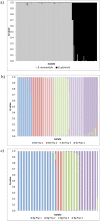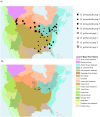Phylogeographic Analysis of Blastomyces dermatitidis and Blastomyces gilchristii Reveals an Association with North American Freshwater Drainage Basins
- PMID: 27428521
- PMCID: PMC4948877
- DOI: 10.1371/journal.pone.0159396
Phylogeographic Analysis of Blastomyces dermatitidis and Blastomyces gilchristii Reveals an Association with North American Freshwater Drainage Basins
Abstract
Blastomyces dermatitidis and Blastomyces gilchristii are dimorphic fungal pathogens that cause serious pulmonary and systemic infections in humans. Although their natural habitat is in the environment, little is known about their specific ecologic niche(s). Here, we analyzed 25 microsatellite loci from 169 strains collected from various regions throughout their known endemic range in North America, representing the largest and most geographically diverse collection of isolates studied to date. Genetic analysis of multilocus microsatellite data divided the strains into four populations of B. dermatitidis and four populations of B. gilchristii. B. dermatitidis isolates were recovered from areas throughout North America, while the B. gilchristii strains were restricted to Canada and some northern US states. Furthermore, the populations of both species were associated with major freshwater drainage basins. The four B. dermatitidis populations were partitioned among (1) the Nelson River drainage basin, (2) the St. Lawrence River and northeast Atlantic Ocean Seaboard drainage basins, (3) the Mississippi River System drainage basin, and (4) the Gulf of Mexico Seaboard and southeast Atlantic Ocean Seaboard drainage basins. A similar partitioning of the B. gilchristii populations was observed among the more northerly drainage basins only. These associations suggest that the ecologic niche where the sexual reproduction, growth, and dispersal of B. dermatitidis and B. gilchristii occur is intimately linked to freshwater systems. For most populations, sexual reproduction was rare enough to produce significant linkage disequilibrium among loci but frequent enough that mating-type idiomorphic ratios were not skewed from 1:1. Furthermore, the evolutionary divergence of B. dermatitidis and B. gilchristii was estimated at 1.9 MYA during the Pleistocene epoch. We suggest that repeated glaciations during the Pleistocene period and resulting biotic refugia may have provided the impetus for speciation as theorized for other species associated with temperate freshwater systems.
Conflict of interest statement
Figures



References
-
- Kasuga T, White TJ, Koenig G, McEwen J, Restrepo A, Castaneda E, et al. Phylogeography of the fungal pathogen Histoplasma capsulatum. Mol Ecol. 2003;12: 3383–3401. - PubMed
MeSH terms
Substances
LinkOut - more resources
Full Text Sources
Other Literature Sources

